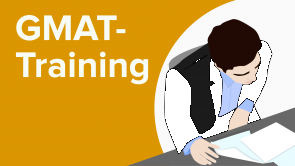(dt.) Reading Comprehension - Verbal Section (Kapitel 3, Teil 2)

Über den Vortrag
Im zweiten verbalen Teil liegt der Fokus auf dem Fragetyp „Reading Comprehension“. Zunächst werden Strategien für das richtige Lesen von RC Texten besprochen und Tricks und Kniffe gezeigt wie man Fragen aus dieser Kategorie schneller und sicherer löst. Auch hier gibt es wieder 3 Textpassage mit jeweils bis zu acht Fragen an denen die Lösungsstrategien anschaulich erklärt werden.Der Vortrag „(dt.) Reading Comprehension - Verbal Section (Kapitel 3, Teil 2)“ von Dr. Patrick Planing ist Bestandteil des Kurses „GMAT-Training“. Der Vortrag ist dabei in folgende Kapitel unterteilt:
- Reading Comprehension - Einführung
- Reading Comprehension - Strategien
- Reading Comprehension - Tipps & Tricks
- RC - Text 1 (leicht)
- RC 1 - Frage 1 (leicht)
- RC 1 - Frage 1 (leicht) - Lösung
- RC 1 - Frage 2 (leicht)
- RC 1 - Frage 2 (leicht) - Lösung
- RC 1 - Frage 3 (leicht)
- RC 1 - Frage 3 (leicht) - Lösung
- RC 1 - Frage 4 (leicht)
- RC 1 - Frage 4 (leicht) - Lösung
- RC 1 - Frage 5 (leicht)
- RC 1 - Frage 5 (leicht) - Lösung
- RC 1 - Frage 6 (leicht)
- RC 1 - Frage 6 (leicht) - Lösung
- RC 1 - Frage 7 (leicht)
- RC 1 - Frage 7 (leicht) - Lösung
- RC Text 2 (mittel)
- RC 2 - Frage 1 (mittel)
- RC 2 - Frage 1 (mittel) - Lösung
- RC 2 - Frage 2 (mittel)
- RC 2 - Frage 2 (mittel) - Lösung
- RC 2 - Frage 3 (mittel)
- RC 2 - Frage 3 (mittel) - Lösung
- RC 2 - Frage 4 (mittel)
- RC 2 - Frage 4 (mittel) - Lösung
- RC 2 - Frage 5 (mittel)
- RC 2 - Frage 5 (mittel) - Lösung
- RC Text 3 (schwer)
- RC3 - Frage 1 (schwer)
- RC3 - Frage 1 (schwer) - Lösung
- RC3 - Frage 2 (schwer)
- RC3 - Frage 2 (schwer) - Lösung
- RC3 - Frage 3 (schwer)
- RC3 - Frage 3 (schwer) - Lösung
- RC3 - Frage 4 (schwer)
- RC3 - Frage 4 (schwer) - Lösung
- RC3 - Frage 5 (schwer)
- RC3 - Frage 5 (schwer) - Lösung
- RC3 - Frage 6 (schwer)
- RC3 - Frage 6 (schwer) - Lösung
- RC3 - Frage 7 (schwer)
- RC3 - Frage 7 (schwer) - Lösung
- RC3 - Frage 8 (schwer)
- RC3 - Frage 8 (schwer) - Lösung
Quiz zum Vortrag
Wie viele Fragen gibt es normalerweise zu einer Reading Comprehension Passage?
- 3-5
- 1
- 1-2
- 2-3
Wie kann man sich ein großes Englisch-Vokabular aneignen?
- Englische Publikationen lesen (z.B. "The Economist")
- Englische TV-Serien schauen
- Das Sprach- und Hörverständnis trainieren
- Die offizielle GMAT Vokabelliste auswendig lernen
Was für Textarten gibt es im GMAT?
- Wirtschaftswissenschaftliche Texte
- Sozialwissenschaftliche Texte
- Naturwissenschaftliche Texte
- Juristische Texte
Wozu dient das erste Lesen einer Reading Comprehension Passage?
- Es dient dazu, sich die Struktur des Textes einzuprägen oder zu notieren.
- Es dient dazu, sich jedes relevante Detail des Textes einzuprägen.
- Es dient dazu, sich jedes relevante Detail des Textes zu notieren.
- Es dient dazu, gedanklich Gegenargumente vorzubereiten.
Worauf zielt die erste Frage einer Reading Comprehension Passage, die sog. "General Question", grds. ab?
- Auf die Struktur und den Aufbau der gesamten Textpassage
- Auf ein Detail aus der Textpassage
- Auf einen Sachverhalt, den man aus dem Inhalt des Textes ableiten kann
- Auf den letzten Paragraphen der Textpassage
Welche Aussagen stimmen bzgl. der 2. - 5. Frage im Reading Comprehension Teil?
- Es handelt sich um "Specific Questions".
- Diese zielen auf ein Detail im Text ab.
- Es handelt sich, wie bei der 1. Frage auch, um sog. "General Questions".
- Diese zielen auf die Gesamtstruktur des Textes ab.
Welche Antworten sollte man bei Reading Comprehension Fragen grds. vermeiden?
- Zu emotionale Antworten
- Antworten, die genau so oder mit anderen Worten im Text stehen.
- Zu lange Antworten
- Antworten, die sich nur auf den ersten Paragraphen beziehen.
Von welchen "Essentials" spricht der Vortragende in Bezug auf die Textstruktur?
- Trigger Words
- Continuing Words
- Yin-Yang Words
- Ambivalent Words
- Moving Words
Was sagen einem "Continuing Words"?
- Der Paragraph geht in die selbe Richtung weiter.
- Der Paragraph geht in die entgegengesetzte Richtung weiter.
- Der Paragraph ist eine Täuschung, da es sich um eine umformulierte Wiederholung handelt.
- Der Paragraph enthält einen unlogischen Vergleich.
Was sind Beispiele für "Trigger Words"?
- Nevertheless
- Despite
- In addition
- Thus
- Likewise
Was ist das wichtigste Tool bei der Reading Comprehension?
- POE
- Plugging-In
- Error Log
- Paper Based Analysis
Wie soll man bei den sog. "Inference Questions" vorgehen?
- Man sollte etwas suchen, was genauso im Text steht, aber mit anderen Worten formuliert ist.
- Die richtige Antwort bezieht sich immer direkt darauf, was im Text steht.
- Man sollte die entsprechende Aussage ableiten.
- Mit "Inference Questions" sollte genauso umgegangen werden, wie mit "Specific Questions".
Was sind Synonyme für "misconception"?
- Delusion
- Fallacy
- Certainty
- Surety
- Reality
Was sind Synonyme für "reconcile"?
- Accomodate
- Appease
- Assuage
- Agitate
- Incite
Was bedeutet "refute"?
- Widerlegen
- Anfechten
- Entkräften
- Besänftigen
- Entfalten
Was bedeutet "tenet"?
- Grundsatz
- Grundidee
- Grundstück
- Grundform
Welche Aussagen stimmen bzgl. der sog. "Except Fragen"?
- Bei einer "Except Frage" muss man vier Dinge finden, die so im Text stehen, und die übrig gebliebene Möglichkeit ist die richtige Antwort.
- "Except Fragen" gibt es auch in anderen Teilen des GMAT, wie z.B. im Critical Reasoning Teil.
- "Except Fragen" gibt es nur in diesem Teil des GMAT.
- Bei einer "Except Frage" muss man zwei Dinge finden, die so im Text stehen, und die übrig gebliebenen Möglichkeiten sind die potentiellen Lösungen.
Was sind Synonyme für "scornful"?
- Contemptuous
- Disdainful
- Sneering
- Flattering
- Gracious
Woran sollte man denken, wenn in Antwortmöglichkeiten Wörter wie "only" und "most" vorkommen?
- Es handelt sich um extreme Antworten und solche sind fast immer falsch.
- Diese Wörter sind leicht angreifbar, sodass richtige Antworten diese Wörter nicht enthalten.
- Es handelt sich um Antworten, die auf Fakten basieren, sodass die Chance groß ist, dass es richtige Antworten sind.
- Diese Antworten sind abschließend, sodass kein Raum für Interpretation bleibt.
Was sind Synonyme für "assumption"?
- Belief
- Hunch
- Inference
- Measurement
- Proof
Die richtige Antwort im GMAT ist stets ...
- ... politisch korrekt.
- ... inhaltlich korrekt.
- ... neutral formuliert.
- ... vielseitig formuliert.
- ... anspruchsvoll.
Diese Kurse könnten Sie interessieren
Kundenrezensionen
3,8 von 5 Sternen
| 5 Sterne |
|
2 |
| 4 Sterne |
|
0 |
| 3 Sterne |
|
1 |
| 2 Sterne |
|
1 |
| 1 Stern |
|
0 |
4 Kundenrezensionen ohne Beschreibung
4 Rezensionen ohne Text
Auszüge aus dem Begleitmaterial
... Bad news: GMAC asks you to read long, awful, complex paragraphs within a few seconds and to answer 3-5 questions, which often cover very detailed facts or even inferences of the ...
... general question or a specific question: – General question like: ”What is the main statement of the text?” Try to find an own answer before looking at the given ones, then eliminate answers that focuses only at a part of the passage or state information that is not given in the text. – Specific question: look for ...
... “however, but, yet, despite, while, nevertheless …” are a sign that this paragraph changes the direction and will therefore disagree with what is stated before. – Continuing words like: “first of all, second, in addition, thus, likewise…” let you know that this paragraph will not change the path. – Yin-Yang Words: ...
... text is written as an objective passage about a subject (as most GMAT RC texts are), then avoid answers for the general question that express an opinion, e.g. “argue”, “recommend“, “criticize” etc. Avoid emotional answers. Normally one passage is about ...
... expect Japanese auto plants in the United States to perform no better than factories run by United States companies. This is not the case; Japanese-run automobile plants located in the United States and staffed by local workers have demonstrated higher levels of productivity when compared with factories owned by United States companies. Other observers link high Japanese productivity to higher levels of capital investment per worker. But a historical perspective leads to a different conclusion. When the two top Japanese automobile makers matched and then doubled United States productivity levels in the mid-sixties, capital investment per employee was comparable to that of United States firms. Furthermore, by the late seventies, the amount of fixed assets ...



